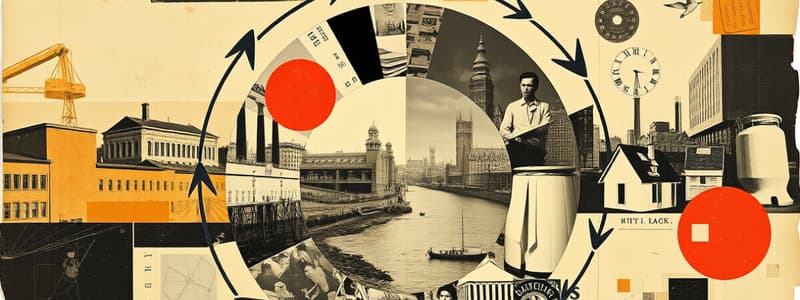Podcast
Questions and Answers
The simple circular flow model shows that:
The simple circular flow model shows that:
- Households are on the selling side of the resource market and on the buying side of the product market. (correct)
- Businesses are on the buying side of the product market and on the selling side of the resource market.
- Households are on the buying side of both product and resource markets.
- Businesses are on the selling side of both product and resource markets.
Which of the following is a distinguishing feature of a command system?
Which of the following is a distinguishing feature of a command system?
Central planning.
In terms of the circular flow diagram, businesses obtain revenue through the _____ market and make expenditures in the _____ market.
In terms of the circular flow diagram, businesses obtain revenue through the _____ market and make expenditures in the _____ market.
product; resource
In the simple circular flow model:
In the simple circular flow model:
The dollar votes of consumers ultimately determine the composition of output and the allocation of resources in a market economy. This statement best describes the concept of:
The dollar votes of consumers ultimately determine the composition of output and the allocation of resources in a market economy. This statement best describes the concept of:
Enterprise managers and workers in the Soviet Union often resisted innovations in production methods because:
Enterprise managers and workers in the Soviet Union often resisted innovations in production methods because:
Arrows (3) and (4) represent:
Arrows (3) and (4) represent:
Economic systems differ according to which two main characteristics?
Economic systems differ according to which two main characteristics?
(Consider This) North Korea's command economy:
(Consider This) North Korea's command economy:
Which of the following is a distinguishing feature of laissez-faire capitalism?
Which of the following is a distinguishing feature of laissez-faire capitalism?
The guiding function of prices tends to keep resources flowing toward their most highly valued uses.
The guiding function of prices tends to keep resources flowing toward their most highly valued uses.
Money functions as a medium of exchange by eliminating the need for a coincidence of wants.
Money functions as a medium of exchange by eliminating the need for a coincidence of wants.
Market economies use capital goods because they improve productive efficiency.
Market economies use capital goods because they improve productive efficiency.
Continued losses in an industry will cause some firms to reduce output or eventually leave the industry.
Continued losses in an industry will cause some firms to reduce output or eventually leave the industry.
The invisible hand refers to the many indirect controls that the federal government imposes in a market system.
The invisible hand refers to the many indirect controls that the federal government imposes in a market system.
Flashcards are hidden until you start studying
Study Notes
Circular Flow Model
- In the simple circular flow model, households act as buyers in both product and resource markets while businesses serve as sellers.
- Households supply resources to the resource market and purchase final products from the product market.
Economic Systems
- A distinguishing feature of a command system is central planning, contrasting with private ownership of capital and reliance on markets.
- Economic systems differ based on ownership of production factors and coordination methods.
Circular Flow Diagram
- Businesses generate revenue in the product market and incur expenditures in the resource market.
Consumer Sovereignty
- Consumer spending decisions, described as "dollar votes," dictate output composition and resource allocation in a market economy.
Resistance to Innovation
- In the Soviet Union, enterprise managers and workers resisted production innovations due to increased production targets associated with such changes.
Identifying Diagram Components
- In a circular flow diagram, arrows representing incomes and consumer expenditures indicate the flow of money in the economy.
North Korea's Economy
- North Korea is noted as one of the few remaining command economies, lacking significant market reforms and exhibiting slower economic performance compared to South Korea.
Laissez-Faire Capitalism
- Laissez-faire capitalism is characterized by minimal government intervention across economic activities.
Price Mechanism
- The guiding function of prices helps direct resources to their most valued uses, reflecting market efficiency.
Money Functions
- Money serves as a medium of exchange, effectively removing the necessity for a coincidence of wants in trade.
Capital Goods
- Market economies utilize capital goods to enhance productive efficiency, leading to greater output.
Industry Dynamics
- Persistent losses in an industry will compel firms to cut back on output or exit the market entirely.
Invisible Hand Concept
- The invisible hand symbolizes market mechanisms that operate without government intervention, promoting efficient resource allocation.
Studying That Suits You
Use AI to generate personalized quizzes and flashcards to suit your learning preferences.




